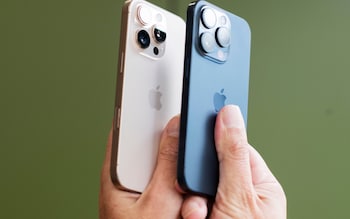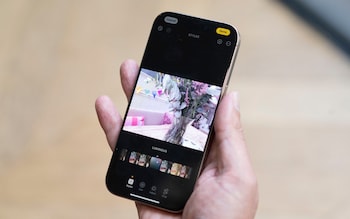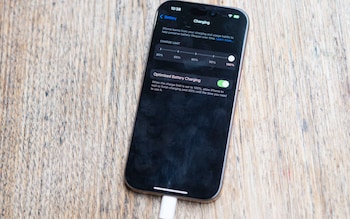Price: from £799 for iPhone 16, or from £999 for iPhone 16 Pro
Our rating: 9 out of 10
We like:
- More buttons
- Great photo features
- Better battery life
We don’t like:
- Not a huge upgrade over the 15
- Few AI features yet
- Camera fiddly at first
What is the iPhone 16 ?
Released in September 2024, the new iPhone 16 marks a welcome continuing shift from Apple towards having more buttons and physical controls on devices, reversing the trend for each smartphone generation to remove useful buttons and ports. It’s one of the best smartphones you can buy.
We tested the iPhone 16 Pro, the premium version, which costs £999 for the 128GB model. It’s £1,199 if you choose 256GB of storage, £1,299 for 512 GB and £1,499 for 1TB. There is also an iPhone 16 Pro Max which has the same capabilities but a larger screen. It costs £200 more.
The Max is a vast iPhone, at a previously unheard of 6.9 inches, but it is a gorgeous device – as is the 16, which itself is larger than the preceding iPhone 15. Its 6.3-inch screen is a welcome increase, largely achieved by narrowing the bezels.
There’s a lot to like here: the new camera button and functions, explained below, make this feel more ‘camera-like’ than just about anything out there. Meanwhile, the promised Apple Intelligence features which will arrive later this year offer an intriguing glimpse of an AI-powered future.
How we test smartphones

We test each new phone for at least a week in real-world situations, making calls, downloading data and running power-hungry and graphically demanding apps such as games and hi-def video to push its limits. We’re looking for a comfortable and well laid-out design, a clear, bright screen and hardware (CPU, GPU, sensors and speakers) that can easily handle multiple functions.
We rate the quality of the camera, including the lenses, the sensor and any zoom or low light capabilities. We test all the programmes for enhancing and editing photographs, judging them by the end results and how easy they are to use.
We also consider all the other software, especially AI, that makes the phone stand out from its competitors and from previous models.
Finally, we test the phone’s battery life by running it completely flat with continuous real-world use and timing how long it takes to fully recharge.
Visit our Who We Are page to learn more about Telegraph Recommended reviews.
iPhone 16 Pro review
Design and usability: 9 out of 10

The big news on the design and usability front is the two new(ish) buttons. The Action Button, introduced on last year’s iPhone 15, makes a welcome return, but is now accompanied by a camera button – of which more below. This new button adds more versatility for users who were using the Action Button to launch the camera.
As before, the Action Button is fully customisable. By default, it puts silent mode on but it can be set to record Voice Memos, turn on Flashlight and activate shortcuts. You can even, for some reason, set the Action Button to do nothing. In a world where it is often far too hard to work out how to turn smartphones off and on, the addition of more buttons is to be applauded.
Last year’s Dynamic Island returns and the screen is a tiny bit bigger than last year’s Pro (6.3 inches, compared to 6.1), with a very crisp, bright Super Retina XDR display at 2622x1206 pixel resolution and support for 1 nit minimum brightness. This means the screen can go far darker.
Camera: 10/10
The new camera button is superb, instantly elevating the iPhone 16 Pro above most rivals: it’s just easier to take a shot, with the app opening on one press of the button. A half-press brings up a focus menu and functions menu. Another full press takes a shot.
You can scroll through options by stroking along the top. It’s fiddly to begin with, but haptic feedback steers you down the right path and it’s a great addition to the phone.
The camera performance is excellent, with additions including a 48 megapixel ultrawide and the ability to shoot video at 120 frames per second in 4K, enabling some truly cinematic effects for creative users. A neat tool enables users to cut out background noise while filming, while another enables users to almost get rid of wind noise in the background.
Photo software and image AI: 8/10

Apple has updated its Photographic Styles to make it even easier to edit photos after the shot have been taken. The results are pretty spectacular, enabling you to completely change the mood and feel of an image.
The new Photographic Styles ‘understands’ skin tones better, and if you like a particular ‘look’ you can then select that as a default in the Camera app so all your photos will look like that.
There’s also the option to transform entire scenes, with settings such as ‘Luminous’, creating social-media-friendly looks which ape vintage and arty photographs. New controls allow users to adjust tone and colour in the styles using sliders, offering an incredible amount of control.
Other software and AI: 7/10
Apple trumpeted its adoption of artificial intelligence (AI) to the heavens at its annual iPhone launch event. However, the first thing you notice when you switch on iPhone 16 Pro is that it isn’t actually there.
These vaunted ‘Apple Intelligence’ features, which include an updated Siri, generative AI emojis called GenMoji, and various writing tools, are launching in the U.S. first and are set to arrive in the UK later in the year, with Siri expected in the New Year.
From a quick glimpse on the developer-only beta test, Apple’s tools look competent but not exactly overwhelming, although an AI-supercharged Siri (able to interact with multiple apps so it can find a message, regardless of which app it was sent in) could be an appealing prospect.
Apart from AI, there are a few neat extras here in the form of added customisability. Users are able to add apps and widgets anywhere, and even turn app widgets monochrome and match them to their background image.
Battery life: 10/10

In many ways, the iPhone 16 Pro isn’t a massive upgrade on last year’s iPhone 15 Pro apart from the useful camera button and the thinner bezel on the screen. There are a couple of new colours and a new A18 processor, which Apple promises is 15 percent faster on CPU tasks and 20 percent faster on GPU.
The battery life, however, is notably upgraded from last year’s model, lasting up to four hours longer with video playback, thanks in part to that A18 Pro chip, which uses second-generation three-nanometer technology for more energy efficiency.
The battery is also a touch ‘cleaner’, with 100 percent recycled cobalt and 95 percent recycled lithium. Like last year’s, there’s a USB-C port, which makes it considerably easier if you’re switching from Android as you’ll already have compatible chargers.
Technical specifications
Telegraph verdict: 9/10
This is a really excellent device, particularly for anyone moderately serious about smartphone photography or video, with real, physical buttons making it easier and faster to use the camera.
Like a fine wine, it’s also going to improve with age, with Apple Intelligence set to add new features this winter and into the coming year. iPhone 15 owners will also be able to update their OS to take advantage of the new features, but not owners of the iPhone 14 or older models.
So is it worth the upgrade? The improved battery life might be what swings it for iPhone 15 Pro owners, but the bigger screen and thinner bezel make this a really appetising choice overall. It’s not cheap, but then iPhone Pro models never are, and this looks set to be a powerful, sleek launchpad for the age of Apple Intelligence.
FAQs
When does the iPhone 16 come out?
It has been available in the UK since September 20.
How much does the iPhone 16 cost?
The most affordable iPhone 16 is the 128GB base model, for £799. The iPhone 16 Pro, which has more features, starts at £999 for the 128GB model. The iPhone 16 Pro Max, with a 6.9-inch screen, starts at £1,199 for the 256GB model.
What are the key features of the iPhone 16?
The most notable new feature is the new Camera Button, allowing you to change camera settings while you’re framing a shot with various gestures and pressures. There is a new ultra-wide camera for close-up photography and a new ‘3D’ photography option called Spatial Capture.
There are now three settings for audio in your videos: In-Frame, Studio and Cinematic. You can now choose Photographic Styles and apply them to all your photographs.
Aside from photography features, the iPhone 16 has a new, faster processor called the A18 and its battery lasts longer than the iPhone 15. You can now customise the colour of widgets on your homescreen and set the Action Button to carry out a variety of tasks at one click.
Finally, there are a range of AI features called Apple Intelligence which will launch in the UK some time around the end of 2024. You will need an iPhone 16 or iPhone 15 to use these.
What is the battery life like on the iPhone 16?
You should get 22 hours of video playback. A 50 percent charge takes 30 minutes.
- Compare mobile phone deals this September to get an iPhone 16 on contract
Disclaimer: The copyright of this article belongs to the original author. Reposting this article is solely for the purpose of information dissemination and does not constitute any investment advice. If there is any infringement, please contact us immediately. We will make corrections or deletions as necessary. Thank you.



